艺术设计英语Renaissance-Art文艺复兴
娱乐与文化英语词汇大全
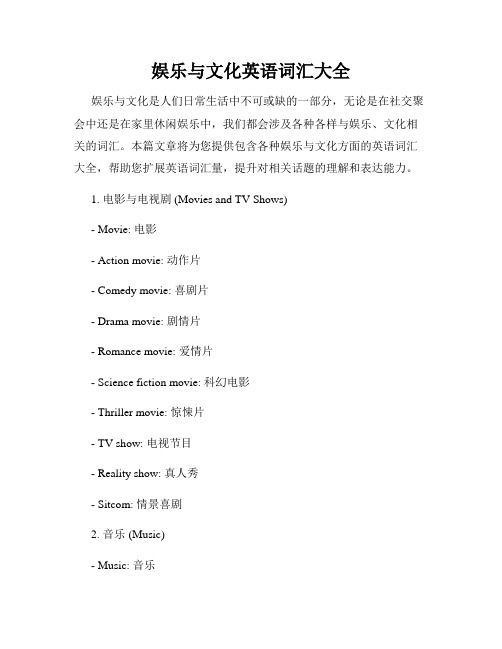
娱乐与文化英语词汇大全娱乐与文化是人们日常生活中不可或缺的一部分,无论是在社交聚会中还是在家里休闲娱乐中,我们都会涉及各种各样与娱乐、文化相关的词汇。
本篇文章将为您提供包含各种娱乐与文化方面的英语词汇大全,帮助您扩展英语词汇量,提升对相关话题的理解和表达能力。
1. 电影与电视剧 (Movies and TV Shows)- Movie: 电影- Action movie: 动作片- Comedy movie: 喜剧片- Drama movie: 剧情片- Romance movie: 爱情片- Science fiction movie: 科幻电影- Thriller movie: 惊悚片- TV show: 电视节目- Reality show: 真人秀- Sitcom: 情景喜剧2. 音乐 (Music)- Music: 音乐- Song: 歌曲- Singer: 歌手- Band: 乐队- Album: 专辑- Concert: 音乐会- Pop music: 流行音乐- Rock music: 摇滚音乐- Classical music: 古典音乐- Jazz music: 爵士音乐3. 艺术 (Art)- Art: 艺术- Painting: 绘画- Sculpture: 雕塑- Photography: 摄影- Exhibition: 展览- Gallery: 美术馆- Artwork: 艺术品- Abstract art: 抽象艺术- Modern art: 现代艺术- Renaissance art: 文艺复兴艺术4. 游戏与体育 (Games and Sports) - Game: 游戏- Video game: 电子游戏- Board game: 桌游- Card game: 纸牌游戏- Sports: 体育运动- Soccer: 足球- Basketball: 篮球- Tennis: 网球- Swimming: 游泳- Gymnastics: 体操5. 阅读与写作 (Reading and Writing) - Book: 书籍- Novel: 小说- Fiction: 小说- Non-fiction: 非小说类书籍- Poetry: 诗歌- Magazine: 杂志- Newspaper: 报纸- Writer: 作家- Plot: 情节- Character: 人物角色6. 剧院与表演艺术 (Theater and Performing Arts) - Theater: 剧院- Play: 剧本- Actor: 演员- Actress: 女演员- Stage: 舞台- Performance: 表演- Musical: 音乐剧- Ballet: 芭蕾舞- Opera: 歌剧- Drama: 戏剧7. 节日与庆典 (Holidays and Celebrations) - Holiday: 假日- Christmas: 圣诞节- New Year: 新年- Easter: 复活节- Halloween: 万圣节- Thanksgiving: 感恩节- Birthday: 生日- Wedding: 婚礼- Anniversary: 周年纪念日- Celebration: 庆典8. 美食与烹饪 (Food and Cooking)- Food: 食物- Dish: 菜肴- Recipe: 食谱- Cooking: 烹饪- Cuisine: 美食- Restaurant: 餐厅- Chef: 主厨- Ingredient: 食材- Appetizer: 开胃菜- Dessert: 甜点通过学习这些娱乐与文化的英语词汇,您将更好地理解和参与到与这些话题相关的讨论和活动中。
艺术的黄金时代英语

艺术的黄金时代英语一、单词1. renaissance- 英语释义:a period of new growth or activity, especially in art, literature, and music.(尤指艺术、文学和音乐方面的)复兴,再生。
- 用法:可以用作名词,如The Renaissance was a great period for art in Europe.(文艺复兴时期是欧洲艺术的伟大时期。
) - 双语例句:The city experienced a renaissance in architecture during the last decade.(这座城市在过去十年里经历了建筑方面的复兴。
)2. flourish- 英语释义:to grow or develop successfully; to be very active and successful.繁荣,兴旺,茁壮成长。
- 用法:可作不及物动词,如Art flourishes in a stable society.(艺术在稳定的社会中繁荣发展。
)也可作及物动词,如They flourished their business with new marketing strategies.(他们用新的营销策略使生意兴旺起来。
)- 双语例句:The local theater has flourished under new management.(在新的管理下,当地剧院蓬勃发展。
)3. masterpiece- 英语释义:a work of art such as a painting, film, or book that is made with great skill.杰作,名著。
- 用法:名词,如This painting is considered a masterpiece of the Renaissance.(这幅画被认为是文艺复兴时期的杰作。
意大利文艺复兴艺术 英文
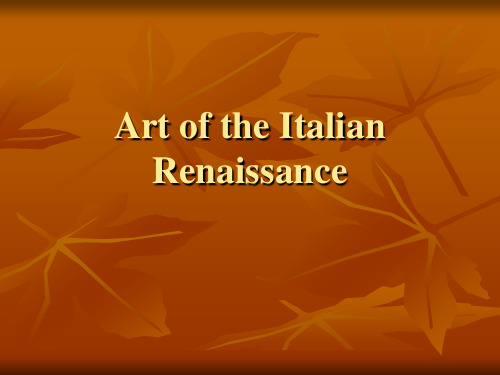
Which one seems to be a warmer, more inviting atmosphere? Why?
Proto-Renaissance
This period, roughly 1200 1400 A.D., is the time that the Italian style was just beginning to show breaks from the Byzantine and Gothic styles. We see the first attempts to display realism and greater interest in depicting the human form.
Renaissance Art
The changes that the Renaissance precipitated are most evident in the art of that period. There was an evolution from the strict, symbolic figures of the Middle Ages, to the fluid, emotion-filled figures that gave life to Renaissance art.
Proto-Renaissance Art: Giotto
Giotto di Bondone (c. 1267 - 1337) was a Florentine painter and architect.
He was recognized as the first artistic genius of the Italian Renaissance. He dealt largely in the traditional religious subjects, but he gave these subjects an earthly, fullblooded life and force.
文艺复兴时期的艺术-意大利(英文)
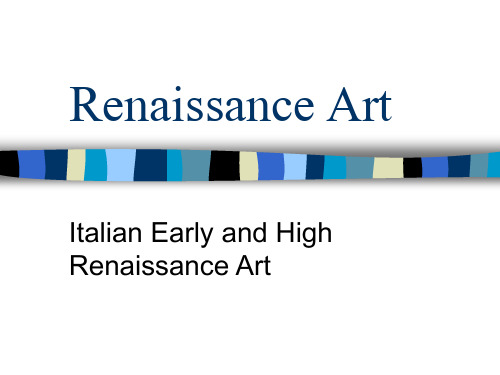
Characteristics of Renaissance Art
3. Classicism
The “Classical Pose” Medici “Venus”
Greco-Roman influence.
Secularism.
Humanism.
Individualism free standing figures.
Dominican friar who decried money and power.
Anti-humanist he saw humanism as too secular, hedonistic, and corrupting.
The “Bonfire of the Vanities,” 1497.
Cultural icon
The Last Supper
Emotions Response
Michelangelo
David
Michelangelo Buonarotti
1504 Marble
Raphael School of Athens 1510
Da Vinci Michelangelo
Giorgio Vasari
1550
Early Renaissance
The First Three Hall-of-Famers
Masaccio
1401-1428
Founder of early Renaissance Painting
Painted human figure as a real human being
Symmetry/Balance
4. Emphasis on Individualism
西方美术英语

西方美术英语西方美术英语:1. Renaissance Art (文艺复兴艺术)The Renaissance was a period of great creativity and thought that greatly influenced art. This art style is characterized by a focus on realism, perspective, and classical forms. Painters like Leonardo da Vinci, Michelangelo, and Botticelli were some of the most famous and influential artists of the Renaissance.2. Baroque Art (巴洛克艺术)The Baroque period was marked by an emphasis on grandeur and exaggerated motion. Artists like Caravaggio, Rembrandt, and Rubens created dramatic and emotional works of art that reflected the tumultuous times in which they lived.3. Romanticism (浪漫主义)The romantic period was a reaction against the rationalism of the Enlightenment. Artists like Caspar David Friedrich, William Blake, and Francisco Goya created works of art that depicted a range of emotions from ecstasy to despair.4. Impressionism (印象派)The impressionist movement was characterized by a focus on light, color, and brushstrokes. Artists like Claude Monet, Edgar Degas, and Auguste Renoir created works of art that captured fleeting moments of life and nature.5. Cubism (立体主义)Cubism was a revolutionary art movement that broke down objects into geometric shapes and planes. Artists like Pablo Picasso and Georges Braque created works of art that challenged traditional notions of space and perspective.6. Surrealism (超现实主义)Surrealism was an art movement that sought to explore the subconscious through art. Artists like Salvador Dali, Max Ernst, and Rene Magritte created works of art that were dreamlike and often unsettling.7. Abstract Expressionism (抽象表现主义)Abstract Expressionism was a post-World War II art movement that emphasized spontaneity and emotion. Artists like Jackson Pollock, Mark Rothko, and Willem de Kooning created works of art that were characterized by dynamic and expressive brushwork.以上便是西方美术的几个主要流派,每一个都有着自己独特的特点。
美术史常考的英文名词解释

美术史常考的英文名词解释美术史是研究艺术作品的创造、传承和影响的学科。
在学习美术史的过程中,我们经常会遇到一些英文名词,了解这些名词的含义对于理解艺术作品以及相关研究非常重要。
本文将解释一些常见的美术史英文名词,帮助读者更好地理解和掌握美术史知识。
1. Renaissance(文艺复兴): This term refers to a period in European history, roughly between the 14th and 17th centuries, when there was a renewed interest in the arts, sciences, and learning. The Renaissance marked a transition from the Middle Ages to the modern era, and was characterized by the revival of classical art forms, such as naturalistic representations and perspective.2. Impressionism(印象派): Impressionism was an art movement that emerged in the late 19th century. It focused on capturing the fleeting, ever-changing impressions of light, color, and atmosphere in the natural world. Impressionist artists often used loose brushwork, vibrant colors, and an emphasis on capturing the effects of light rather than meticulous detail.3. Cubism(立体派): Developed in the early 20th century, Cubism was an innovative art movement pioneered by Pablo Picasso and Georges Braque. It challenged traditional notions of perspective and representation by depicting objects from multiple viewpoints simultaneously, using geometric forms and fragmented compositions.4. Surrealism(超现实主义): Surrealism was a cultural and artistic movement that emerged in the early 20th century. Influenced by Freudian psychology, it aimed to explore the realm of the subconscious and dreams. Surrealist artworks often featured bizarre, dreamlike imagery, irrational juxtapositions, and an emphasis on the unconscious mind.5. Baroque(巴洛克): Baroque is a style that originated in Europe during the 17th century. It is characterized by ornate, dramatic, and extravagant elements, such aselaborate decoration, dynamic compositions, and theatrical effects. Baroque art often served to convey religious or political messages in a grandiose and visually striking manner.6. Abstract Expressionism(抽象表现主义): Developed in the mid-20th century, Abstract Expressionism was an art movement that rejected representational imagery in favor of purely abstract forms. Artists of this movement used spontaneous, gestural brushwork to convey emotion and explore the subconscious. It emphasized individuality, freedom of expression, and the act of creating itself.7. Pop Art(波普艺术): Pop Art emerged in the 1950s and 1960s as a reaction against the established art world. It celebrated consumer culture, mass media, and everyday objects through a combination of bold colors, commercial imagery, and irony. Pop artists, such as Andy Warhol and Roy Lichtenstein, often appropriated popular images and icons from advertising and media.8. Neoclassicism(新古典主义): Neoclassicism was an art movement that emerged in the late 18th century as a reaction against the excesses of the Baroque and Rococo styles. It sought to revive the classical ideals of ancient Greece and Rome, emphasizing simplicity, clarity, and order in its art and architecture. Neoclassical works often depicted historical or mythological subjects.9. Realism(现实主义): Realism emerged in the mid-19th century as a reaction against the romanticized depictions of the Neoclassical and Romantic periods. It aimed to depict everyday life and ordinary people in a straightforward, unembellished manner. Realist artworks often conveyed a social or political message and emphasized accurate representation of details and natural lighting.10. Rococo(洛可可): Rococo was a decorative arts movement that flourished in 18th-century Europe, particularly in France. It was characterized by elaborate ornamentation, pastel colors, and a playful, frivolous spirit. Rococo art often depicted subjects from the aristocratic lifestyle and emphasized charm, grace, and sensuality.这些是美术史中常见的英文名词解释,掌握了这些名词的含义,可以更好地理解和欣赏各个时期和风格的艺术作品。
复兴的英语单词
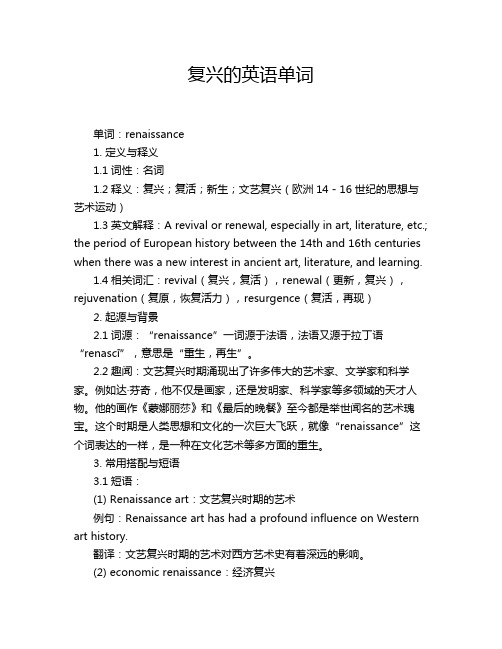
复兴的英语单词单词:renaissance1. 定义与释义1.1词性:名词1.2释义:复兴;复活;新生;文艺复兴(欧洲14 - 16世纪的思想与艺术运动)1.3英文解释:A revival or renewal, especially in art, literature, etc.; the period of European history between the 14th and 16th centuries when there was a new interest in ancient art, literature, and learning.1.4相关词汇:revival(复兴,复活),renewal(更新,复兴),rejuvenation(复原,恢复活力),resurgence(复活,再现)2. 起源与背景2.1词源:“renaissance”一词源于法语,法语又源于拉丁语“renascī”,意思是“重生,再生”。
2.2趣闻:文艺复兴时期涌现出了许多伟大的艺术家、文学家和科学家。
例如达·芬奇,他不仅是画家,还是发明家、科学家等多领域的天才人物。
他的画作《蒙娜丽莎》和《最后的晚餐》至今都是举世闻名的艺术瑰宝。
这个时期是人类思想和文化的一次巨大飞跃,就像“renaissance”这个词表达的一样,是一种在文化艺术等多方面的重生。
3. 常用搭配与短语3.1短语:(1) Renaissance art:文艺复兴时期的艺术例句:Renaissance art has had a profound influence on Western art history.翻译:文艺复兴时期的艺术对西方艺术史有着深远的影响。
(2) economic renaissance:经济复兴例句:The government is working hard to bring about an economic renaissance in this region.翻译:政府正在努力使这个地区实现经济复兴。
文艺复兴运动名词解释
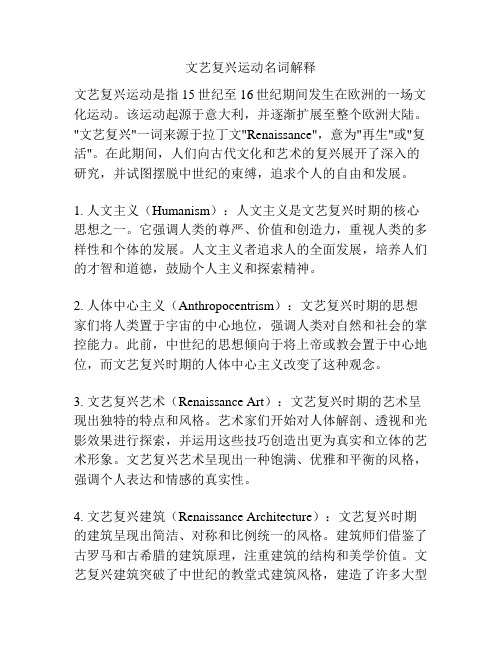
文艺复兴运动名词解释文艺复兴运动是指15世纪至16世纪期间发生在欧洲的一场文化运动。
该运动起源于意大利,并逐渐扩展至整个欧洲大陆。
"文艺复兴"一词来源于拉丁文"Renaissance",意为"再生"或"复活"。
在此期间,人们向古代文化和艺术的复兴展开了深入的研究,并试图摆脱中世纪的束缚,追求个人的自由和发展。
1. 人文主义(Humanism):人文主义是文艺复兴时期的核心思想之一。
它强调人类的尊严、价值和创造力,重视人类的多样性和个体的发展。
人文主义者追求人的全面发展,培养人们的才智和道德,鼓励个人主义和探索精神。
2. 人体中心主义(Anthropocentrism):文艺复兴时期的思想家们将人类置于宇宙的中心地位,强调人类对自然和社会的掌控能力。
此前,中世纪的思想倾向于将上帝或教会置于中心地位,而文艺复兴时期的人体中心主义改变了这种观念。
3. 文艺复兴艺术(Renaissance Art):文艺复兴时期的艺术呈现出独特的特点和风格。
艺术家们开始对人体解剖、透视和光影效果进行探索,并运用这些技巧创造出更为真实和立体的艺术形象。
文艺复兴艺术呈现出一种饱满、优雅和平衡的风格,强调个人表达和情感的真实性。
4. 文艺复兴建筑(Renaissance Architecture):文艺复兴时期的建筑呈现出简洁、对称和比例统一的风格。
建筑师们借鉴了古罗马和古希腊的建筑原理,注重建筑的结构和美学价值。
文艺复兴建筑突破了中世纪的教堂式建筑风格,建造了许多大型的宫殿、教堂和市政建筑。
5. 文艺复兴文学(Renaissance Literature):文艺复兴时期的文学作品多样且富有创造力。
文艺复兴文学借鉴了古希腊和古罗马文学的风格和主题,强调个人情感和经历的表达。
重要的作家包括达·芬奇、米开朗基罗、但丁、莎士比亚等。
6. 文艺复兴科学(Renaissance Science):文艺复兴时期的科学研究呈现出活跃和创新的特点。
文艺复兴英文单词
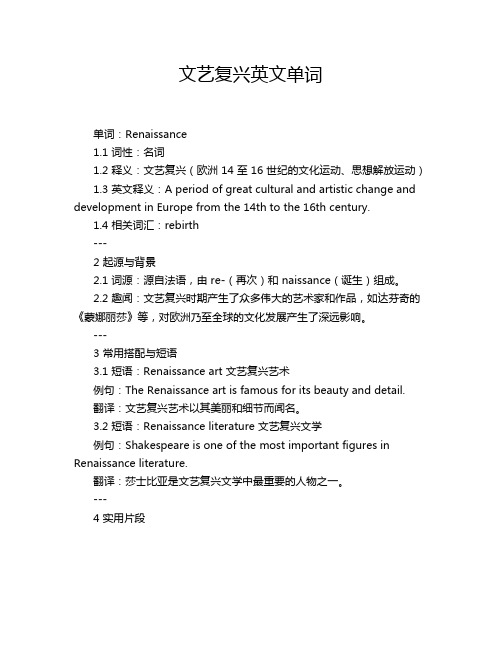
文艺复兴英文单词单词:Renaissance1.1 词性:名词1.2 释义:文艺复兴(欧洲 14 至 16 世纪的文化运动、思想解放运动)1.3 英文释义:A period of great cultural and artistic change and development in Europe from the 14th to the 16th century.1.4 相关词汇:rebirth---2 起源与背景2.1 词源:源自法语,由 re-(再次)和 naissance(诞生)组成。
2.2 趣闻:文艺复兴时期产生了众多伟大的艺术家和作品,如达芬奇的《蒙娜丽莎》等,对欧洲乃至全球的文化发展产生了深远影响。
---3 常用搭配与短语3.1 短语:Renaissance art 文艺复兴艺术例句:The Renaissance art is famous for its beauty and detail.翻译:文艺复兴艺术以其美丽和细节而闻名。
3.2 短语:Renaissance literature 文艺复兴文学例句:Shakespeare is one of the most important figures in Renaissance literature.翻译:莎士比亚是文艺复兴文学中最重要的人物之一。
---4 实用片段(1) "I'm studying the Renaissance period in history class. It's so fascinating to learn about the great thinkers and artists of that time." said Tom. "Yes, the Renaissance was a time of great innovation and creativity." replied the teacher.翻译:“我在历史课上学习文艺复兴时期。
艺术Art时代周刊常用词汇21艺...
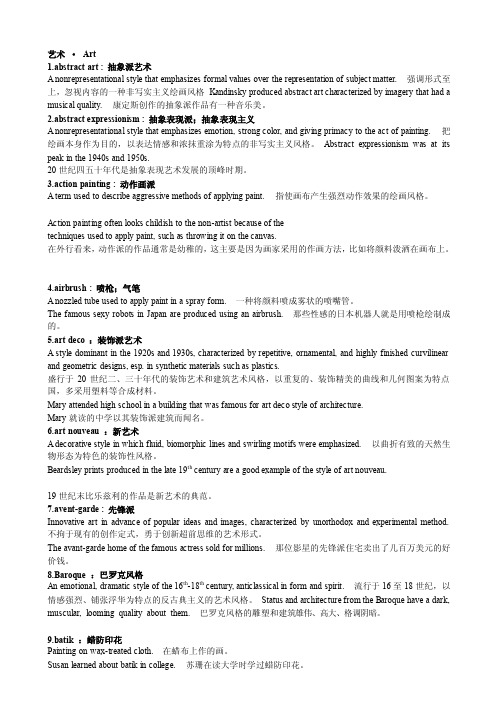
艺术·Art1.abstract art : 抽象派艺术A nonrepresentational style that emphasizes formal values over the representation of subject matter. 强调形式至上,忽视内容的一种非写实主义绘画风格Kandinsky produced abstract art characterized by imagery that had a musical quality. 康定斯创作的抽象派作品有一种音乐美。
2.abstract expressionism : 抽象表现派;抽象表现主义A nonrepresentational style that emphasizes emotion, strong color, and giving primacy to the act of painting. 把绘画本身作为目的,以表达情感和浓抹重涂为特点的非写实主义风格。
Abstract expressionism was at its peak in the 1940s and 1950s.20世纪四五十年代是抽象表现艺术发展的顶峰时期。
3.action painting : 动作画派A term used to describe aggressive methods of applying paint. 指使画布产生强烈动作效果的绘画风格。
Action painting often looks childish to the non-artist because of thetechniques used to apply paint, such as throwing it on the canvas.在外行看来,动作派的作品通常是幼稚的,这主要是因为画家采用的作画方法,比如将颜料泼洒在画布上。
Renaissance文艺复兴英文介绍

David (1504) by Michelangelo
In essence,
the Renaissance is a historical period in which the European humanist thinkers attempted to lift the restrictions in all areas placed by Roman Catholic Church and to introduce new ideas expressing the interest of the rising bourgeoisie.
1.1 What is Renaissance?
Renaissance refers to the activity, spirit and time of the revival of art, learning, and literature in Europe extending over a period of 300 years (1350-1650), marking a transition from the Middle Ages to the modern time.
Assignment
A Presentation on William Shakespeare
Humanism
A Different View of Humanity Human beings are glorious creatures capable of individual development toward the direction of perfection. Human beings live in this world not to suffer merely but to interrogate, to explore and to enjoy.
历史英语词汇大全帮助你理解和研究历史文化

历史英语词汇大全帮助你理解和研究历史文化在研究历史文化时,了解历史英语词汇是至关重要的。
这些词汇不仅能帮助我们理解历史事件和文化现象,还能揭示当时人们的思维方式和价值观。
本文将为您介绍一些常见的历史英语词汇,帮助您更好地理解和研究历史文化。
一、政治和社会制度1. Monarchy(君主制): 表示国家的最高权力由君主掌握的政治制度。
在君主制下,君主通常通过继承或选举的方式获得权力。
2. Democracy(民主制): 表示国家的最高权力由人民行使的政治制度。
民主制下,人民通过选举或公民投票的方式来决定国家的事务。
3. Revolution(革命): 指的是一种对现有政治或社会体制进行彻底改变的行动或运动。
革命往往伴随着大规模的社会动荡和政治权力的转移。
4. Empire(帝国): 指的是一个国家或地区通过征服其他国家或地区而形成的庞大政治实体。
帝国往往由一个皇帝或帝王统治。
5. Feudalism(封建制度): 是一种中世纪时期的社会和经济制度。
封建制度下,领主通过将土地授予农民的方式来换取其效忠和劳动。
二、战争和冲突1. Battle(战役): 指的是两个或多个军队之间的武装冲突。
战役往往是战争中的一个重要组成部分。
2. Treaty(条约): 是两个或多个国家之间达成的正式协议。
条约通常用于结束战争、确立边界或解决争端。
3. Siege(围攻): 是一种军事行动,指的是军队包围并困住敌方城市或堡垒,以迫使其放弃。
4. Alliance(联盟): 表示两个或多个国家或组织之间的正式合作关系。
联盟的目的可以是共同对抗其他威胁或实现共同利益。
5. Rebellion(叛乱): 指的是一群人对现有政权进行反抗或起义的行动。
叛乱往往由于政府压迫、不公正或不满所引起。
三、文化和艺术1. Renaissance(文艺复兴): 是欧洲历史上的一段时期,标志着艺术、文学和科学的繁荣和复兴。
文艺复兴时期对人类知识和文化的重要贡献至今仍受到赞誉。
文艺复兴名词解释
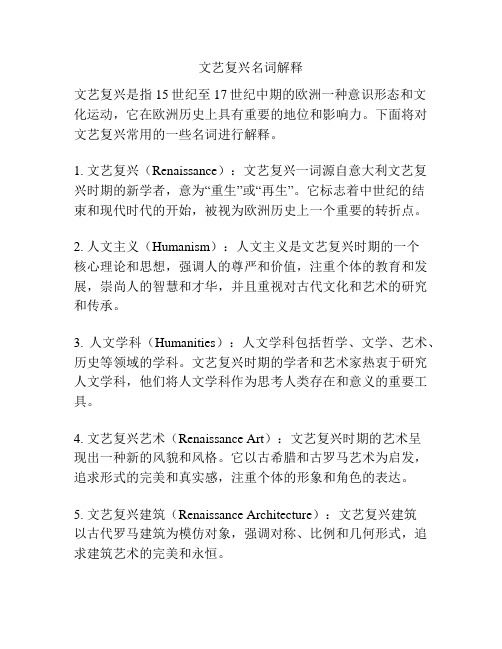
文艺复兴名词解释文艺复兴是指15世纪至17世纪中期的欧洲一种意识形态和文化运动,它在欧洲历史上具有重要的地位和影响力。
下面将对文艺复兴常用的一些名词进行解释。
1. 文艺复兴(Renaissance):文艺复兴一词源自意大利文艺复兴时期的新学者,意为“重生”或“再生”。
它标志着中世纪的结束和现代时代的开始,被视为欧洲历史上一个重要的转折点。
2. 人文主义(Humanism):人文主义是文艺复兴时期的一个核心理论和思想,强调人的尊严和价值,注重个体的教育和发展,崇尚人的智慧和才华,并且重视对古代文化和艺术的研究和传承。
3. 人文学科(Humanities):人文学科包括哲学、文学、艺术、历史等领域的学科。
文艺复兴时期的学者和艺术家热衷于研究人文学科,他们将人文学科作为思考人类存在和意义的重要工具。
4. 文艺复兴艺术(Renaissance Art):文艺复兴时期的艺术呈现出一种新的风貌和风格。
它以古希腊和古罗马艺术为启发,追求形式的完美和真实感,注重个体的形象和角色的表达。
5. 文艺复兴建筑(Renaissance Architecture):文艺复兴建筑以古代罗马建筑为模仿对象,强调对称、比例和几何形式,追求建筑艺术的完美和永恒。
6. 文艺复兴人物(Renaissance Figures):文艺复兴时期涌现了很多重要的人物,如达·芬奇、米开朗琪罗、拉斐尔等艺术家和文化名人,他们的作品和思想对后人产生了深远的影响。
7. 印刷术(Printing Press):印刷术的发明和使用使得书籍的生产和传播变得更加容易和快捷。
这种技术的普及推动了文艺复兴时期知识的传播和教育的普及。
8. 巴洛克艺术(Baroque Art):巴洛克艺术是文艺复兴后期的一种艺术风格,它在形式上更加夸张、动感和情感化,注重运用光影和色彩的对比来表达作品的内在情感。
以上是对文艺复兴时期的一些常用名词的解释。
这些名词涵盖了文艺复兴时期的核心理论、思想和艺术特点,展示了这一时期的开放思想和创造力。
艺术设计英语Renaissance-Art文艺复兴
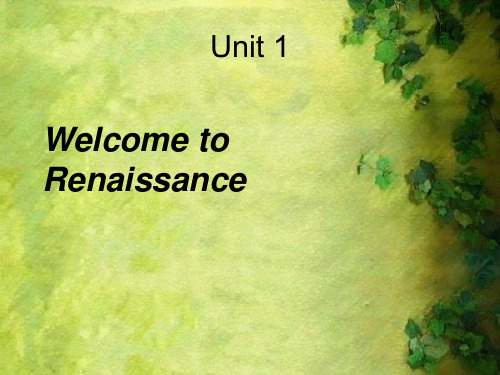
Renaissance Art
Renaissance art , painting , sculpture , architecture , music , and literature produced during the 14th, 15th, and 16th centuries in Europe under the combined influences of an increased awareness of nature, a revival of classical learning, and a more individualistic view of man.
拉斐尔· 桑西(Raphael Cenci)
以画基督教圣母著称的拉斐尔,有多幅圣母像传世。
The Sistine Madonna
《西斯廷圣母》
椅中圣母
《披纱巾的少女》
Renaissance Architecture
文艺复兴时期的建筑
Renaissance Architecture
During the Renaissance, architects were inspired by the symmetrical and well-balanced buildings of Greece and Rome[rəʊm]. Flat roofs, coffered(方格的) ceilings, Roman arches and capitals Reflected the return of interest in the great monuments of antiquity(古 代; 古迹)
画中,與耶稣同坐的十二使徒。头上没有光环的是 出卖耶稣的加略人犹大。光環的形象表示他們被視 為聖人,可在其肖像上以光環標記。
文艺复兴的英文单词

文艺复兴的英文单词“文艺复兴”的英语是“Renaissance”。
一、单词翻译与解释- “Renaissance”源自法语,词干“naiss -”表示“出生”的意思,前缀“re -”有“重新、再”的含义,合起来字面意思就是“重生、再生”,在历史语境中特指14世纪到17世纪在欧洲兴起的一场思想文化运动,强调古典文化的复兴以及在其基础上的创新发展。
二、词干与加前后缀的情况1. 词干单独使用情况较少- 在英语中,词干“naiss -”单独使用的情况非常少,因为它是从法语等语言借入英语的部分词根,在英语中不符合常规的单词构造习惯。
2. 加前缀或后缀的情况- 以“Renaissance”为例,这个词本身已经是一个完整的、具有特定意义的名词,一般不需要再添加后缀来改变词性用于表达“文艺复兴”这个概念。
不过,在一些衍生用法中,可以添加后缀。
例如“Renaissance - like”(像文艺复兴那样的),这里添加“ - like”后缀,将名词“Renaissance”变成了形容词性的短语,表示具有文艺复兴特征的。
- 前缀“re -”在这个词中是不可或缺的,因为如果没有“re -”,“naissance”虽然在法语中有“出生、诞生”的意思,但不能准确表达“重生、复兴”这个对于“文艺复兴”概念至关重要的语义。
三、不同词式的造句及翻译1. 名词形式(Renaissance)- The Renaissance was a period of great cultural change in Europe.(文艺复兴是欧洲一个文化发生巨大变革的时期。
)- Many great artists emerged during the Renaissance.(许多伟大的艺术家在文艺复兴时期涌现出来。
)2. 形容词性短语形式(Renaissance - like)- The city has a Renaissance - like atmosphere with its beautiful architecture and vibrant arts scene.(这个城市有着像文艺复兴那样的氛围,有着美丽的建筑和充满活力的艺术景象。
第六单元意大利文艺复兴的艺术参考译文
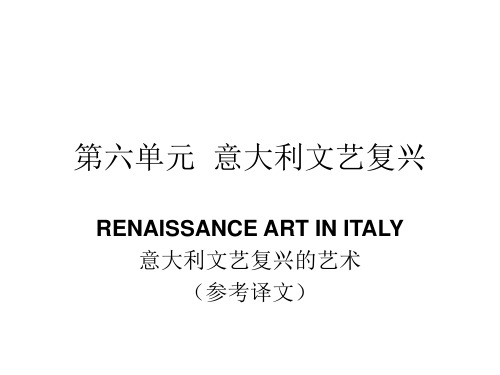
• 在探索新方向上稍显滞后的建筑师们也深 受古典榜样的影响。 • 直到菲利普· 布鲁内莱斯基(1377-1446) 最先运用了数学透视的法则才出现了明显 的革新。 • 布鲁内莱斯基是折中的,在他的教堂建筑 中,他将罗马式建筑的十字架形的平面构 图与诸如柱式、圆形窗户以及拱顶等古典 建筑的特征结合在一起。
• 他最成功的杰作是佛罗伦萨大教堂的圆顶, 可与罗马的万神殿和君士坦丁堡的圣索菲 亚大教堂媲美。
• Artists of the late fifteenth and early sixteenth centuries, in line with Ficino’s (and Plato’s) notion that love of the world’s physical beauty was an initial step toward love of God’s spiritual beauty, sought to make figures more beautiful, and thus more godlike. • Sandro Botticelli (1444-1510) (桑德罗· 波提切 利)particularly embodied that artistic Platonism in painted figures of a mystical beauty.
• 意大利艺术家的一个突出特征是他们对自 然的密切细致观察。 • 这种趋势,在晚期哥特式艺术中很明显, 并为法兰西斯派(方济各会)的教义予以 强化,法兰西斯派人物自然界的一切都是 为了人的幸福而予以的神圣的创造。 • 艺术上的新趋势包括将过去的空白背景用 风景予以替换,以及对于动作和情感表现 的强调。
艺术设计英语Renaissance-Art文艺复兴

文艺复兴美术三杰
❖ 米开朗基罗 Michelangelo ❖ 达·芬奇 Da Vinci ❖ 拉斐尔 Raphael ['reifl, 'ræ feil]
Painting of the Renaissance-Renaissance art 文艺复兴时期的绘画
米开朗基罗· 博那罗蒂(Michelangelo Bo that Rorty)
拉斐尔·桑西(Raphael Cenci) 以画基督教圣母著称的拉斐尔,有多幅圣母像传世。
The Sistine Madonna 《西斯廷圣母》
❖ 椅中圣母
《披纱巾的少女》
Renaissance Architecture 文艺复兴时期的建筑
Renaissance Architecture
During the Renaissance, architects were inspired by the symmetrical and wellbalanced buildings of Greece and Rome[rəʊm].
Listen to the passage twice and fill in the blanks.
Leonardo Da Vinci’s _______fapmorotruasit of the Mona Lisa has a mysterious smile. It will always remain a _______ , but it is possible to hear what her voice would have sounded like, thanks to a Japanese sound expert.
Renaissance Art Brief introduction
- 1、下载文档前请自行甄别文档内容的完整性,平台不提供额外的编辑、内容补充、找答案等附加服务。
- 2、"仅部分预览"的文档,不可在线预览部分如存在完整性等问题,可反馈申请退款(可完整预览的文档不适用该条件!)。
- 3、如文档侵犯您的权益,请联系客服反馈,我们会尽快为您处理(人工客服工作时间:9:00-18:30)。
圣母怜子 价值3亿美元
列奥纳多·达·芬奇 (Leonardo Da Vinci)
renaissance
Art in the Renaissance(文艺复兴时期的艺术) Section Two: Representative Artists & Their Works Da Vinci’s Renaissance pieces like Mona Lisa and The Last Supper revealed the way he looked at situations and people. Besides, they are the most famous, most reproduced and most parodied portrait and religious painting of all time.
• Feature: The Renaissance is characterised by seeking ideological emancipation(解放;使不受法 律、政治或社會的束縛) , intellectual freedom and political awareness, based on cultural production and religious reformation. All these were undertaken or unfolded gradually but widely, extending its influences to every corner of Europe, with more and more people getting involved. The most striking feature of the Renaissance was doubtlessly the flourish of humanism人文主义.
Michelangelo for the huge ceiling painting of the creation of the genesis (创世纪) of the luomaxisiting Church(罗马西斯廷 教堂 ), up to more than 300 people
Michelangelo for the huge ceiling painting of the creation of the genesis (创世纪) of the luomaxisiting Church, people up to
Renaissance Art
Brief introduction
❖ Renaissance art , painting , sculpture , architecture , music , and literature produced during the 14th, 15th, and 16th centuries in Europe under the combined influences of an increased awareness of nature, a revival of classical learning, and a more individualistic view of mreek and Roman (adj.) culture.
3.(欧洲 14、15 和 16 世纪时,人们以古希腊罗 马Rome的思想文化来繁荣文学艺术)
• What is typical of • a Renaissance work of art?
Unit1
• •
WelcometoRenaissanc e
• Art in the Renaissance • (文艺复兴时期的艺术)
• Renaissance • 英 [rɪ‘neɪsns] 美 [‘renəsɑ:ns] • n.文艺复兴; 文艺复兴时期; 文艺
复兴时期; (某一学科或艺术形式 等衰落后的) 复兴;
Art in the Renaissance(文艺复兴时期的艺术) Section Two: Representative Artists & Their Works
1. Leonardo Da Vinci (1452~1519) 列奥纳多·达·芬奇 Leonardo Da Vinci (April 15, 1452-May 2, 1519) was an Italian polymath, scientist, mathematician, engineer, inventor, anatomist, painter, sculptor, architect, botanist, musician and writer. Leonardo has often been described as the representative of the Renaissance men, a man whose never-to-be-satisfied curiosity was equaled only by his powers of invention. He is widely considered to be one of the greatest painters of all time and perhaps the most diversely talented person ever to have lived.
文艺复兴美术三杰
❖ 米开朗基罗 Michelangelo ❖ 达·芬奇 Da Vinci ❖ 拉斐尔 Raphael ['reifl, 'ræ feil]
Painting of the Renaissance-Renaissance
art
文艺复兴时期的绘画
米开朗基罗· 博那罗蒂 (Michelangelo Bo that Rorty)
Feature
Renaissance Art
1. Time: 14th to mid-17th century
2.2. “Renaissance” means rebirth
1. Time: from (between)14th to(and) mid-17th century
2.2. “Renaissance” means rebirth, specifically in this period of history,
